Propagation of Overvoltages in the Form of Impulse, Chopped and Oscillating Waveforms in Transformer Windings—Time and Frequency Domain Approach
Abstract
1. Introduction
2. Characteristic of Voltage Waveforms Applied to Transformer Winding
- (a)
- full lighting impulse,
- (b)
- chopped lighting impulse,
- (c)
- rectangular impulse with a variable risetime,
- (d)
- modulated wavelet, i.e., superposition of a full lighting impulse with an oscillating component.
3. Measurement Setup and Test Object
- ux/l—measurement at tap x/l along the winding,
- u0-max—magnitude of external stimulus applied at winding clamps (tap x/l = 0 and x/l = 1.0).
- ux/l—maximum value obtained for measurement at tap x/l along the winding,
- u0-max—highest magnitude of external stimulus applied at winding clamps (tap x/l = 0 and x/l = 1.0).
4. Overvoltages in Frequency Domain
5. Propagation of Different Waveforms in Transformer Windings in Time Domain
5.1. Full Lightning Voltage Impulse
5.2. Chopped Lightning Voltage Impulse
5.3. Rectangular Voltage Impulse
5.4. Lightning Voltage Impulse with Superimposed Oscilating Wavelet
6. Assessment of Overvoltages in Transformer Windings
- Ux/lmax—highest magnitude of overvoltages occurring at tap x/l during network operation,
- Ux/lmax test—highest magnitude of overvoltages occurring at tap x/l excited by reference voltage impulse.
7. Conclusions
Author Contributions
Funding
Conflicts of Interest
References
- Joint Working Group A2/C4.39-CIGRE. Electrical Transient Interaction between Transformers and the Power System (Part 1-Expertise, Part 2: Case Studies); CIGRE: Paris, France, 2014. [Google Scholar]
- Massaro, U.; Antunes, R. Electrical transient interaction between transformers and power system–Brazilian experience. In International Conference on Power Systems Transients (IPST2009); Publisher: Kyoto, Japan, 2009; pp. 1–6. [Google Scholar]
- Florkowski, M.; Furgał, J. High Frequency Methods for Condition Assessment of Transformers and Electrical Machines; Publishing House AGH: Kraków, Poland, 2013; ISBN 978-83-7464-614-7. [Google Scholar]
- Rocha, C.A.O. Electrical Transient Interaction between Transformers and the Power System; CIGRE-Brazil Joint Working Group JWG–A2/C4-03: Paris, France, 2008; pp. 1–6. [Google Scholar]
- Hori, M.; Nishioka, M.; Ikeda, Y.; Naguchi, K.; Kajimura, K.; Motoyama, H.; Kawamura, T. Internal winding failure due to resonance overvoltages in distribution transformer caused by winter lightning. IEEE Trans. Power Deliv. 2006, 23, 1600–1606. [Google Scholar]
- Lapworth, J.A.; Wilson, A. Transformer internal overvoltages caused by remote energization. In Proceedings of the 2007 IEEE Power Engineering Society Conference and Exposition in Africa-PowerAfrica, Johannesburg, South Africa, 16–20 July 2007; pp. 1–6. [Google Scholar]
- Furgał, J. Analysis of overvoltages in windings of power transformers protected by use of metal oxide surge arresters. Eur. Trans. Electr. Power Eng. 2009, 19, 400–410. [Google Scholar] [CrossRef]
- Shipp, D.D.; Dionise, T.J.; Lorch, V.; MacFarlane, B.G. Transformer failure due to circuit-breaker-induced switching transients. IEEE Trans. Ind. Appl. 2011, 47, 707–718. [Google Scholar] [CrossRef]
- Holdyk, A.; Gustavsen, B. External and internal overvoltages in a 100 MVA transformer during high-frequency transients. In Proceedings of the International Conference on Power System Transmission (IPST), Cavtat, Croatia, 15–18 June 2015; pp. 1–6. [Google Scholar]
- Florkowski, M.; Furgał, J.; Kuniewski, M.; Pająk, P. Comparison of transformer winding responses to standard lightning impulses and operational overvoltages. IEEE Trans. Dielectr. Electr. Insul. 2018, 25, 965–974. [Google Scholar] [CrossRef]
- Srikanta Murthy, A.; Azis, N.; Mohd Yousof, M.F.; Jasni, J.; Othman, M.L.; Talib, M.A.; Das, B.P. Investigation on the Resonant Oscillations in an 11 kV Distribution Transformer under Standard and Chopped Lightning Impulse Overvoltages with Different Shield Placement Configurations. Energies 2019, 12, 1466. [Google Scholar] [CrossRef]
- Zhang, Z.; Gao, W.; Kari, T.; Lin, H. Identification of Power Transformer Winding Fault Types by a Hierarchical Dimension Reduction Classifier. Energies 2018, 11, 2434. [Google Scholar] [CrossRef]
- Popov, M. General Approach for accurate resonance analysis in the transformer. Electr. Power Syst. Res. 2018, 161, 45–61. [Google Scholar] [CrossRef]
- Popov, M.; Grcev, L.; Hoidalen, H.K.; Gustavsen, B.; Terzija, V. Investigation of the Overvoltage and Fast Transient Phenomena on Transformer Terminals by Taking into Account the Grounding Effects. IEEE Trans. Ind. Appl. 2015, 51, 5218–5227. [Google Scholar] [CrossRef]
- IEC 60076-3 Power Transformers–Part 3: Insulation Levels. Dielectric Tests and External Clearances in Air. Available online: https://webstore.iec.ch/publication/62880 (accessed on 8 November 2019).
- IEEE C57.98 Guide for Transformer Impulse Tests. IEEE Power Energy Soc. 2012. [CrossRef]
- Neto, E.T.W.; Lopes, G.P.; Martinez, M.L.B.; Salles, C. Chopped impulses for distribution transformers their importance for dimensioning and performance evaluation. In Proceedings of the 2014 International Conference on Lightning Protection (ICLP), Shanghai, China, 11–18 October 2014; pp. 473–478. [Google Scholar]
- Bhuyan, K.; Chatterjee, S. Electric stresses on transformer winding insulation under standard and non-standard impulse voltages. Electr. Power Syst. Res. 2015, 123, 40–47. [Google Scholar] [CrossRef]
- Florkowski, M.; Furgał, J.; Kuniewski, M. Propagation of overvoltages transferred through distribution transformers in electric networks. IET Gen. Trans. Distr. 2016, 10, 2531–2537. [Google Scholar] [CrossRef]
- Munshi, S.; Roy, C.K.; Biswas, J.R. Computer studies of the performance of transformer windings against chopped impulse voltages. IEE Proc. C 1992, 139, 286–294. [Google Scholar] [CrossRef]
- Standard EN 60071-1 Coordination of Insulation. Definitions, Principles and Rules. Available online: https://webstore.iec.ch/publication/65606 (accessed on 8 November 2019).
- Standard EN 60099-5 Surge Arresters. Recommendation of Selection and Use. Available online: https://webstore.iec.ch/publication/736 (accessed on 8 November 2019).
- Lopez-Fernandez, X.M.; Álvarez-Mariño, C. Induced transient voltage performance between transformers and VCB-severity factors and case studies. IEEE Trans. Power Deliv. 2015, 30, 1137–1144. [Google Scholar] [CrossRef]
- Florkowski, M.; Furgał, J.; Kuniewski, M.; Pająk, P. Investigations of transformer winding response to standard full and chopped lightning impulses. In Proceedings of the 2018 IEEE International Conference on High Voltage Engineering and Application (ICHVE), Athens, Greece, 10–13 September 2018. [Google Scholar]
- Rodrigues, R.B.; Mendes, V.M.F.; Catalão, J.P.S. Analysis of Transient Phenomena Due to a Direct Lightning Strike on a Wind Energy System. Energies 2012, 5, 2545–2558. [Google Scholar] [CrossRef]
- Florkowski, M.; Furgał, J.; Kuniewski, M.; Pająk, P. Propagation of lightning, oscillating and non-standard impulse waveforms in transformer windings. In The International Symposium on High Voltage Engineering; Springer: Cham, Switzerland, 2019. [Google Scholar]
- Xu, B.; Li, Y.; Zhao, J.; Wang, X.; Zhang, R. Simulation of propagation characteristic of ultra high frequency signals in power transformers using finite difference time domain method. In Proceedings of the 2015 5th International Conference on Electric Utility Deregulation and Restructuring and Power Technologies (DRPT), Changsha, China, 26–29 November 2015; pp. 1591–1594. [Google Scholar]
- Wilcox, D.J.; Conlon, M.; Hurley, W.G. Calculation of self and mutual impedances for coils in ferromagnetic cores. IEE Proc. 1988, 135, 470–476. [Google Scholar] [CrossRef]
- Yang, Q.; Su, P.; Chen, Y. Comparison of Impulse Wave and Sweep Frequency Response Analysis Methods for Diagnosis of Transformer Winding Faults. Energies 2017, 10, 431. [Google Scholar] [CrossRef]
- Metal Oxide Surge Arresters Type POLIM-D, ABB Power Distribution. Available online: https://new.abb.com/high-voltage/surge-arresters/medium-voltage-arresters/distribution-systems/polim-d (accessed on 8 November 2019).
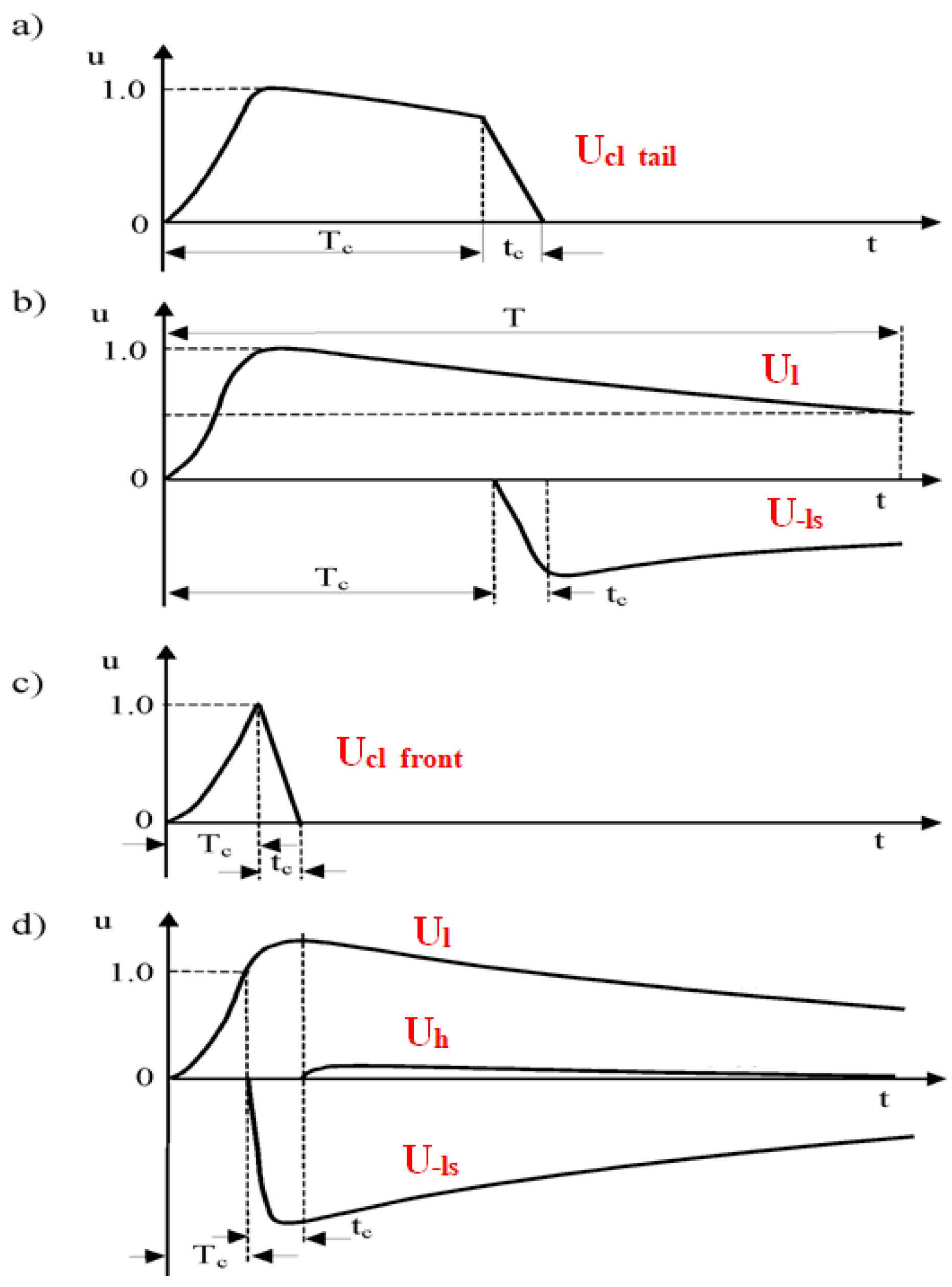





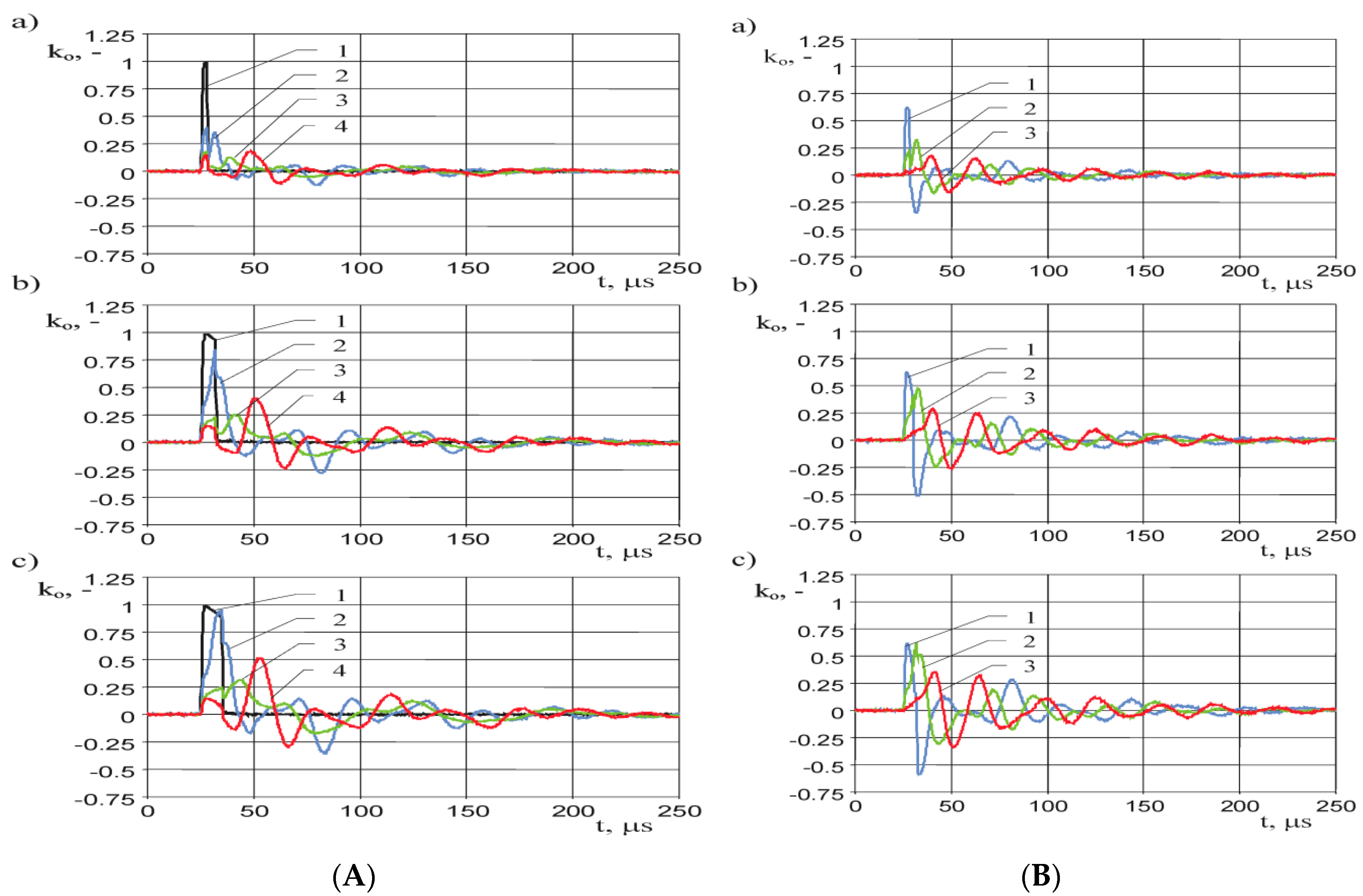

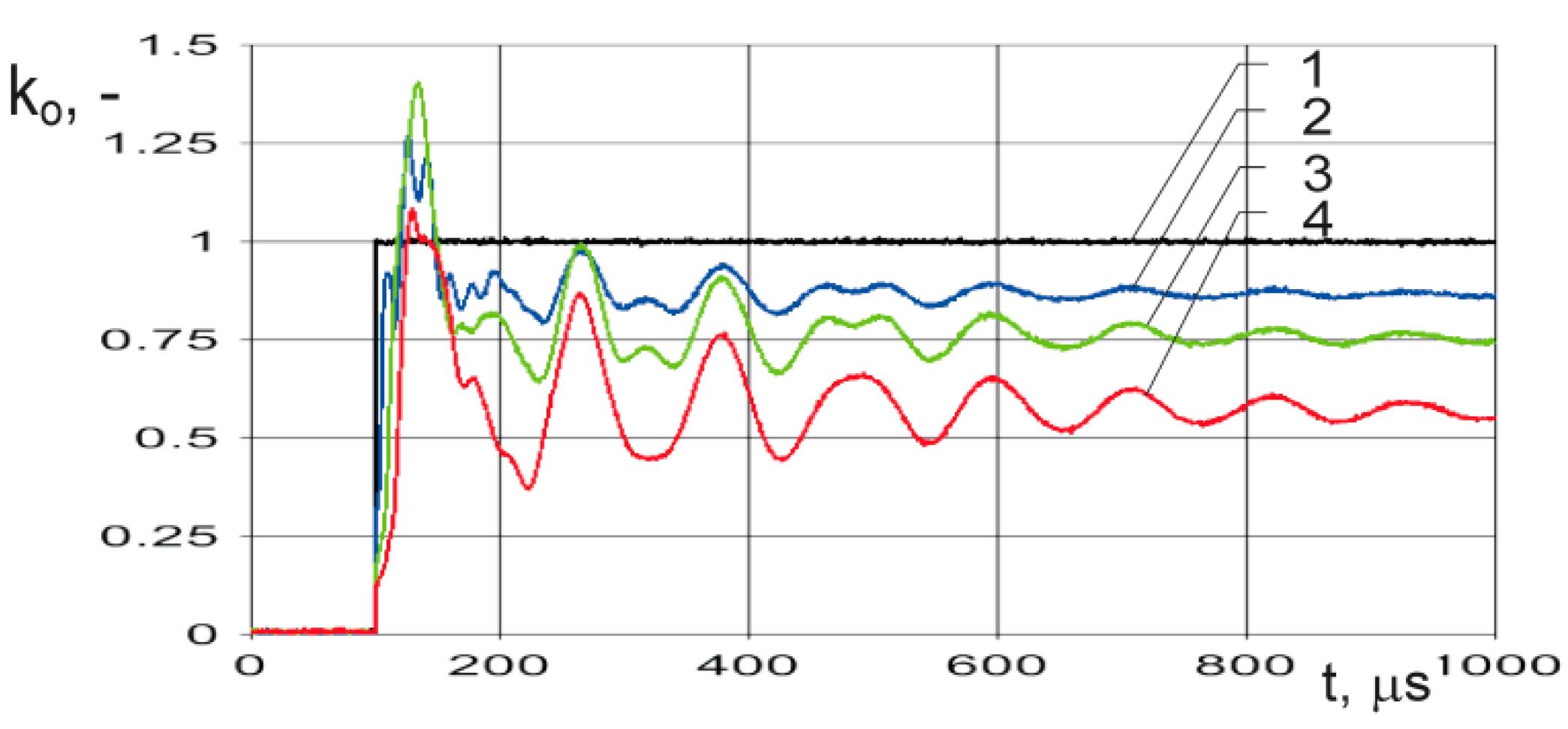

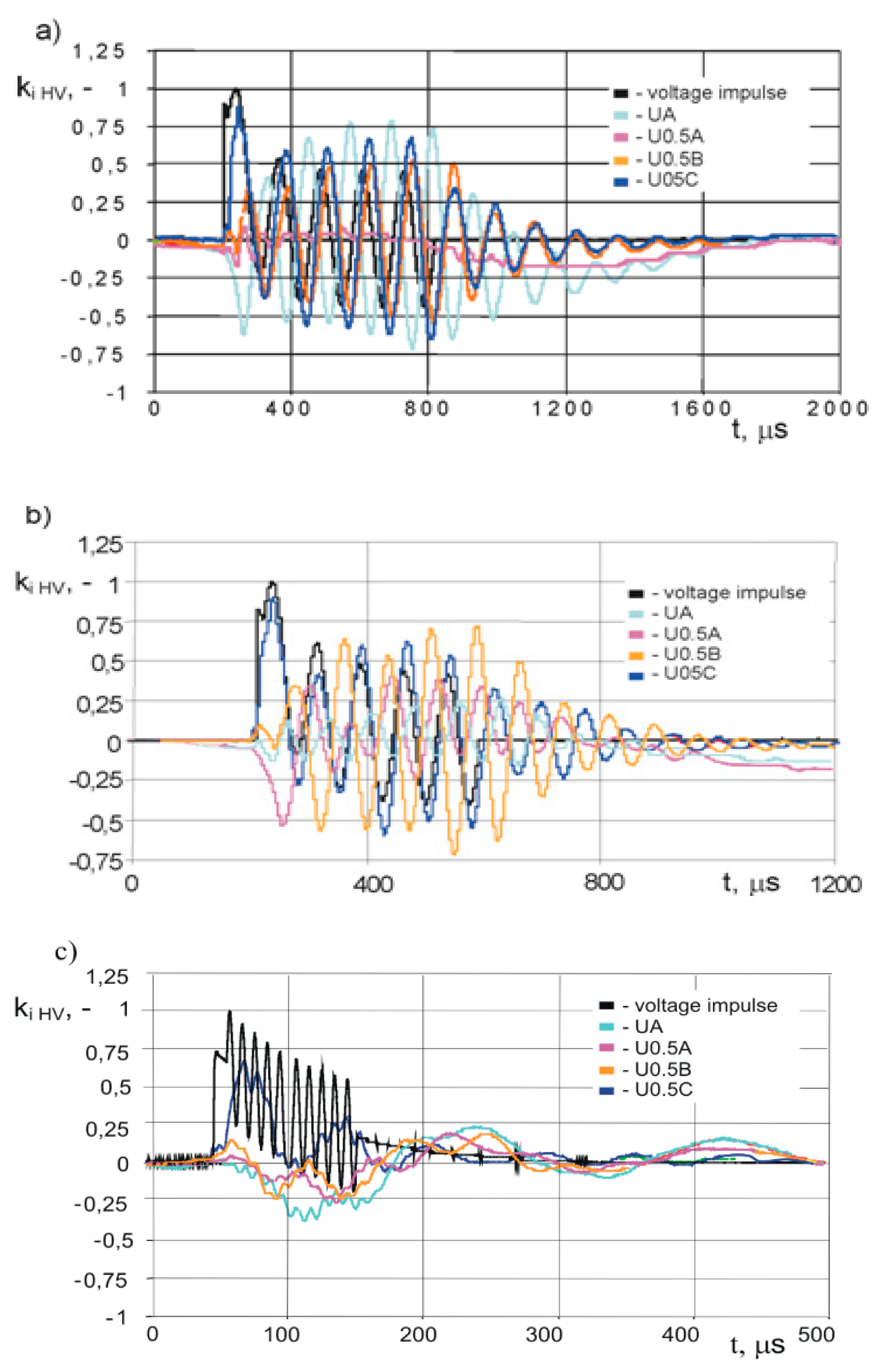
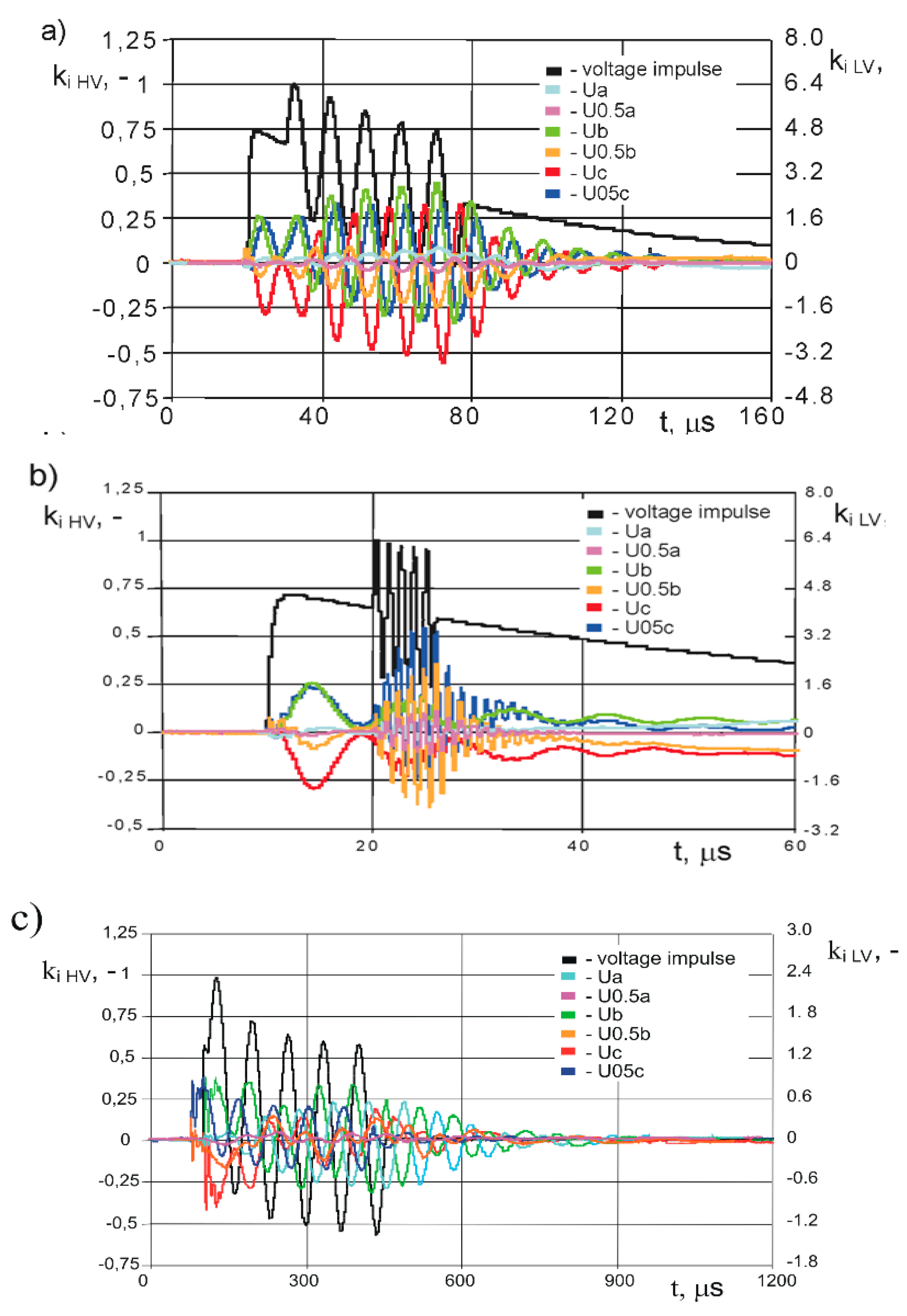
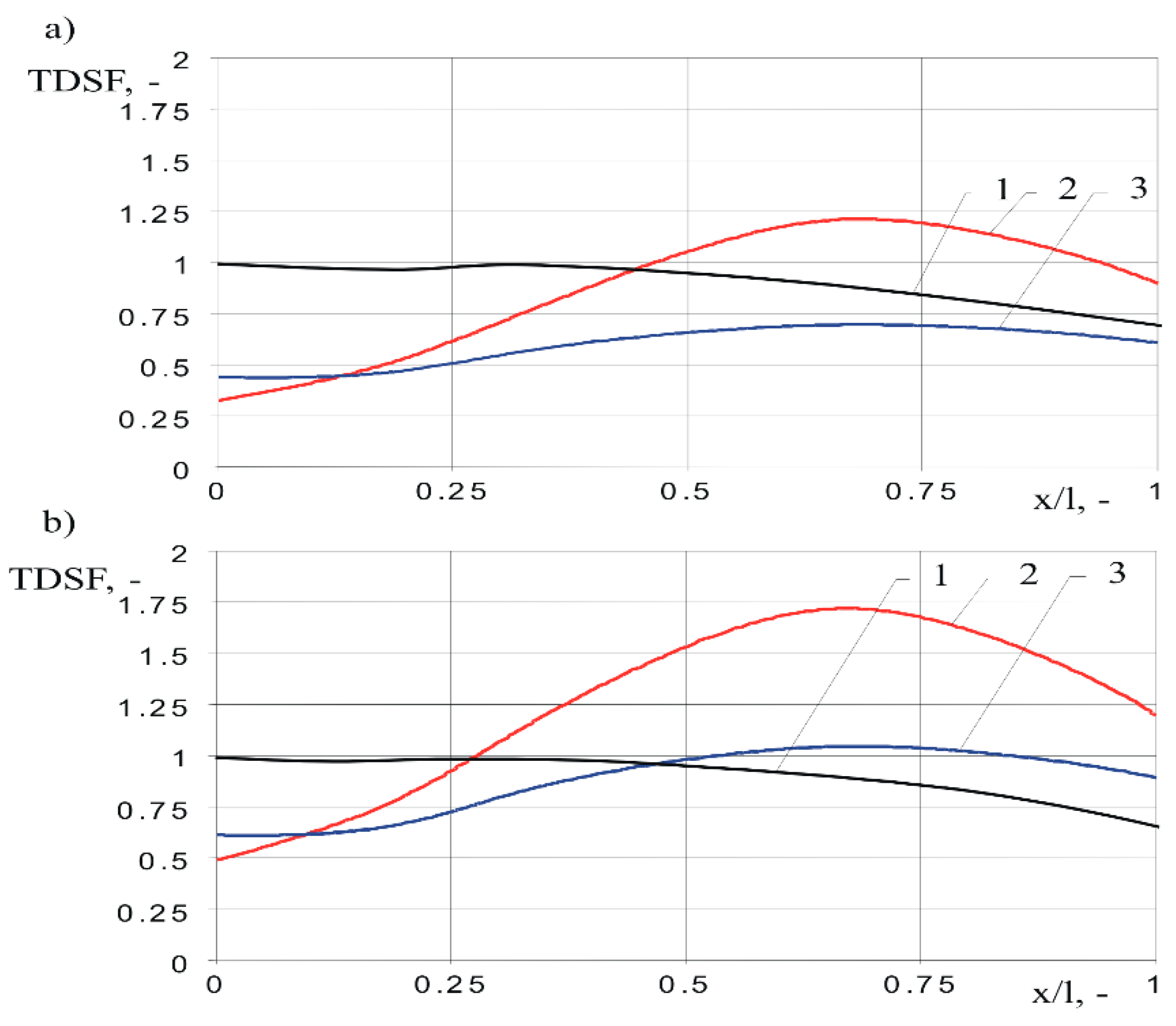
| (a) Full lighting impulse tf—Front time tt—Time to half of wave tail | 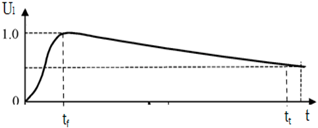 |
| (b) Chopped lighting impulse Tc—Time delay to chopping tc—Collapse time | 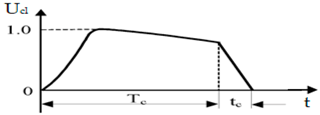 |
| (c) Rectangular impulse with a variable risetime t0—Initial time t1—End of risetime tr—Rise time | 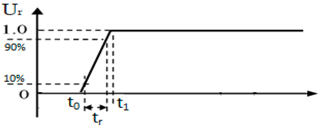 |
| (d) Superposition of full lighting impulse with oscillating component tf—Front time tt—Time to half of wave tail tw1, tw2—Initial and end time of oscillating packet ωw—Frequency of oscillating packet |  |
| Parameter | Value |
|---|---|
| Sr, (kVA) | 20 |
| UrHV, (kV) | 15 |
| UrLV, (kV) | 0.4 |
| number of electrical phases | 3 |
| Uz, (%) | 4.2 |
| ΔPFe, (kW) | 0.11 |
| ΔPk, (kW) | 0.53 |
| I0, (%) | 2.8 |
| number of turns in the coil | 810 |
| number of coils | 4 |
| winding height l, (mm) | 280 |
| internal coil diameter do, (mm) | 157 |
| externat coil diameter di, (mm) | 205 |
| coil width h, (mm) | 25 |
| Winding Position x/l | Reference Test Overvoltages | Overvoltages in Network Operation | |
|---|---|---|---|
| Lightning Impulse 95 kV | Rectangular Impulse | Sinusoidal Oscillating Component | |
| duration: Tens of Microseconds | duration: Milliseconds | ||
| (kV) | |||
| Network with Automatic Fault Clearing (SA1 Uc = 12 kV) | |||
| 0 | 95.0 | 42.0 | 31.1 |
| 0.18 | 95.0 | 53.3 | 48.2 |
| 0.33 | 102.6 | 59.2 | 78.4 |
| 0.67 | 84.6 | 45.4 | 102.6 |
| Network without Automatic Fault Clearing (SA2 Uc = 18 kV) | |||
| 0 | 95.0 | 63.0 | 46.7 |
| 0.18 | 95.0 | 80.0 | 72.4 |
| 0.33 | 102.6 | 88.8 | 117.7 |
| 0.67 | 84.6 | 68.0 | 154.1 |
© 2020 by the authors. Licensee MDPI, Basel, Switzerland. This article is an open access article distributed under the terms and conditions of the Creative Commons Attribution (CC BY) license (http://creativecommons.org/licenses/by/4.0/).
Share and Cite
Florkowski, M.; Furgał, J.; Kuniewski, M. Propagation of Overvoltages in the Form of Impulse, Chopped and Oscillating Waveforms in Transformer Windings—Time and Frequency Domain Approach. Energies 2020, 13, 304. https://doi.org/10.3390/en13020304
Florkowski M, Furgał J, Kuniewski M. Propagation of Overvoltages in the Form of Impulse, Chopped and Oscillating Waveforms in Transformer Windings—Time and Frequency Domain Approach. Energies. 2020; 13(2):304. https://doi.org/10.3390/en13020304
Chicago/Turabian StyleFlorkowski, Marek, Jakub Furgał, and Maciej Kuniewski. 2020. "Propagation of Overvoltages in the Form of Impulse, Chopped and Oscillating Waveforms in Transformer Windings—Time and Frequency Domain Approach" Energies 13, no. 2: 304. https://doi.org/10.3390/en13020304
APA StyleFlorkowski, M., Furgał, J., & Kuniewski, M. (2020). Propagation of Overvoltages in the Form of Impulse, Chopped and Oscillating Waveforms in Transformer Windings—Time and Frequency Domain Approach. Energies, 13(2), 304. https://doi.org/10.3390/en13020304








